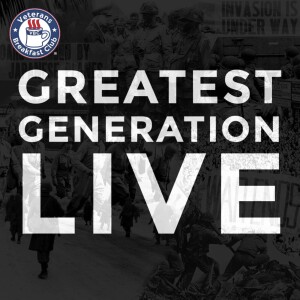Episodes

8 hours ago
8 hours ago
Join the Veterans Breakfast Club for a special 90-minute online conversation with historian Robert S. Norris, author of Racing for the Bomb: General Leslie R. Groves, the Manhattan Project’s Indispensable Man. This event will spotlight the overlooked military mastermind who turned atomic theory into wartime reality: Lt. Gen. Leslie R. Groves.
The Manhattan Project looms large in American memory—Los Alamos, Trinity, Hiroshima—but few remember the man who made it all possible. In Racing for the Bomb, Norris reveals how Groves, often dismissed as a caricature of military bluster, was in fact the indispensable architect of the atomic age. From selecting the sites at Oak Ridge, Hanford, and Los Alamos to coordinating vast industrial-scale construction, international uranium acquisition, bomb design, and the formation of the elite 509th Composite Group of B-29s, Groves ran his own army, treasury, and state department—all under a veil of secrecy.
Robert S. Norris, a leading nuclear historian and former analyst at the Natural Resources Defense Council, brings to life the driven, brusque, and deeply ambitious general whose personal force of will—combined with keen judgment and boundless energy—shaped not just the bomb, but the postwar national security state that emerged from its use. Groves pioneered “black budgets,” security clearances, and compartmentalized intelligence—hallmarks of Cold War secrecy.
Racing for the Bomb is the first full scholarly biography of Groves, completing the unfinished work of historian Stanley Goldberg and offering an authoritative, readable, and revealing portrait based on Groves’s private papers, military records, and firsthand interviews.
Don’t miss this chance to explore the atomic age from a new perspective: not from the scientist’s lab bench, but from the general’s war room. Norris will discuss Groves’s pivotal role in the decision to use the bomb, his fraught but productive relationship with J. Robert Oppenheimer, and the lasting implications of his management style on U.S. defense and intelligence structures.
We’re grateful to UPMC for Life for sponsoring this event!

Friday Jul 11, 2025
Friday Jul 11, 2025
The Veterans Breakfast Club invites you to an in-depth 90-minute livestream event on Thursday, July 10 at 7:00pm ET, focused on one of the most legendary fighting forces of World War II: the U.S. Army Rangers.
Host Glenn Flickinger will lead a conversation with two of the leading experts on Army Ranger history—David Hogan Jr. and Mir Bahmanyar—as they delve deep into the Rangers’ origins, missions, and enduring legacy.
The U.S. Army Rangers were born in 1942 out of the need for agile, highly trained soldiers capable of rapid deployment and specialized operations. Inspired by British Commandos, the Rangers spearheaded some of the most difficult and dangerous missions of the war. They climbed the cliffs at Pointe du Hoc on D-Day, raided Italian strongholds at Cisterna, and faced annihilation and triumph in equal measure.
Who were these men? What distinguished their training, tactics, and culture from conventional forces? And how did their experience shape the future of U.S. special operations?
These questions and more will be explored by:
🔹David Hogan Jr. – A distinguished military historian and senior historian at the U.S. Army Center of Military History. Author of Raiders or Elite Infantry? The Changing Role of the U.S. Army Rangers from Dieppe to Grenada, Hogan brings a deep archival and analytical perspective to the evolution of Ranger forces. Read more: https://warroom.armywarcollege.edu/author/david-hogan
🔹Mir Bahmanyar – A former U.S. Army Ranger turned historian and author of Shadow Warriors: A History of the US Army Rangers. Bahmanyar combines lived experience with scholarly insight and has served as a historical consultant for film and television. Learn more: https://www.mirbahmanyar.com/about
Join us for an evening of rich storytelling, expert analysis, and interactive discussion. Whether you’re a military history buff, a student of World War II, or just curious about America’s elite forces, this program will offer unparalleled insight into the formation and legacy of the Army Rangers.
We’re grateful to UPMC for Life for sponsoring this event!

Thursday Jul 10, 2025
Thursday Jul 10, 2025
In July, an international team, led by famed explorer Dr. Robert Ballard, will launch an expedition to conduct archaeological surveys of historically significant shipwrecks in the Iron Bottom Sound. This confined waterway of the Solomon Islands was the site of five naval battles of Guadalcanal, a defining turning point of World War II. Even after eighty years, to date, only 30 of the military ships lost in this area have been located, with dozens remaining to be found in deep waters.
In locating and exploring these historically significant sites, this expedition intends to honor and keep alive the memory of valiant service and sacrifice made by WWII servicemen, illustrate the importance of protecting cultural heritage sites through interdisciplinary, interagency, and international collaboration, and document the stories contained in the details of the seafloor battlefield. The expedition streams live 24/7 for communities worldwide to explore alongside the team at NautilusLive.org.
Join in a special Greatest Generation Live event from Veterans Breakfast Club and Ocean Exploration Trust to connect the team at sea aboard Exploration Vessel Nautilus. Bring your questions to explore the advanced technology bringing new efficiencies to expeditions, and learn the latest discoveries from one of the world’s most important seafloor battlefields.
We’re grateful to UPMC for Life for sponsoring this event!

Friday Jul 04, 2025
Friday Jul 04, 2025
Join us for a very special Greatest Generation Live livestream event as we dive deep into the history of Gold Beach on D-Day with acclaimed British military historian Tim Saunders MBE MA, co-hosted by Scott Masters, educator and founder of the Crestwood Oral History Project in Toronto, and Glenn Flickinger of the Veterans Breakfast Club.
We’ll also have D-Day veteran Ken Cooke sharing his story. Ken received his draft notice in 1943, after his 18th birthday. On D-Day he crossed the English Channel, after reveille awoke him at 3:00 AM. Ken landed in the second wave on Gold Beach in 6″ of water and was bothered that his socks were wet! Ken’s 50th Division, 6th Battalion cleared villages and marched another 8-9 miles. He was wounded July 4, 1944 from a shell explosion in Hottot-les-Bagues, France where he received shrapnel in his back. He was transported to a first-aid station, and then to a field hospital in Bayeux. Ken boarded a ship for England and was treated at a Scottish hospital, where he was put in a plaster cast from his neck to his waist. He rehabilitated for five months in Scotland. He was given two weeks leave after which he flew from Leeds to Brussels where he joined the Highland Light Infantry. They crossed the Rhine to Bremen. He sustained psychoneurosis during another Bren-Gun-Carrier explosion event and recovered in a Brussels hospital. He was discharged and was transported by the Dakota Air Ambulance. May 8, 1945 at age 19, Ken was demobilized and returned home.
On the morning of June 6, 1944, British forces of the 50th (Northumbrian) Infantry Division stormed ashore at Gold Beach, one of five Allied landing zones in Normandy. Their objective: break through Hitler’s Atlantic Wall, link up with Canadian forces landing at Juno Beach to the east and U.S. troops at Omaha to the west, and push inland to seize the key city of Bayeux and cut the vital Caen–Bayeux road.
Despite heavy resistance, flooded terrain, and daunting German fortifications, British troops overcame the odds, making Gold Beach one of the most successful landing zones on D-Day. But the victory came at a cost—and with stories still waiting to be told.
Tim Saunders served over 30 years in the British Army before dedicating his life to military history. A decorated officer in the Devonshire and Dorset Regiment and later The Rifles, Tim brings an insider’s understanding of battlefield tactics and soldiering to his work as an author, filmmaker, and battlefield guide. He has written over 20 books, many on D-Day and the Normandy Campaign, and produced historical documentaries with Battlefield History TV and Pen & Sword Digital. He lives on the edge of Salisbury Plain, where the sounds of training tanks still echo as he writes.
Scott Masters, one of Canada’s most celebrated educators, is the founder of the Crestwood Oral History Project, an extraordinary archive of hundreds of interviews with veterans, Holocaust survivors, and other witnesses to history. His award-winning work—recognized by the Governor General’s History Award and the Prime Minister’s Award for Teaching Excellence—has transformed how young people engage with the past and honor those who lived it.
We’re grateful to UPMC for Life for sponsoring this event!

Friday Jun 27, 2025
Friday Jun 27, 2025
Join the Veterans Breakfast Club on Thursday, June 26 at 7:00pm ET for a powerful Greatest Generation Live conversation exploring the often-overlooked legacy of World War II: the emotional wounds carried home by veterans and the lasting impact on their families. This free, virtual event will be held on Zoom and streamed to YouTube and Facebook.
Our featured guests are Carol Schultz Vento, daughter of 82nd Airborne Division paratrooper Arthur “Dutch” Schultz, and Susan Friedenberg, daughter of Army medic and D-Day veteran Bernie Friedenberg. Both men served heroically in WWII, both returned home deeply changed by their experiences, and both left lasting imprints on their families.
Carol Schultz Vento is the author of The Hidden Legacy of World War II: A Daughter’s Journey of Discovery, a moving memoir that weaves historical research with personal reflection. Her father, Dutch Schultz, jumped into Normandy on D-Day with the 82nd Airborne and later appeared as himself in the film The Longest Day. Though celebrated for his bravery, Dutch struggled with undiagnosed PTSD throughout his life—a condition that shaped Carol’s upbringing and ultimately led her to uncover his wartime past and her family’s hidden story. Carol’s forthcoming memoir, Twisted Strands: Family Secrets and Intergenerational Trauma, offers an intimate look at how war’s psychological toll can echo through generations.
Joining Carol is Susan Friedenberg, whose father Bernie Friedenberg landed on Omaha Beach as a combat medic and treated the wounded under relentless fire. A Jewish-American war hero who later helped liberate concentration camps, Bernie lived with the psychological burden of his service for the rest of his life. His story is commemorated in a new Atlantic City memorial and honored on the website berniefriedenbergworldwariimemorial.com.
This event promises to be a candid, emotional, and enlightening conversation about courage, trauma, and the enduring bonds between veterans and their children.
We’re grateful to UPMC for Life for sponsoring this event!

Friday Jun 20, 2025
Friday Jun 20, 2025
The Veterans Breakfast Club invites you to a special Greatest Generation Live hosted by Glenn Flickinger. This program will shine a spotlight on an often-overlooked chapter of World War II: the Battle of Normandy from June to August 1944, the brutal and pivotal campaign that followed the famous D-Day landings.
While June 6, 1944—D-Day—has been seared into public memory as a symbol of Allied courage and sacrifice, the bitter, grinding combat that followed in the Norman hedgerows, villages, and fields is less frequently remembered. Yet it was this prolonged and costly battle that ultimately broke the back of German resistance in France and opened the road to Paris and beyond.
Joining Glenn Flickinger is acclaimed military historian Joseph Balkoski, widely recognized as one of the foremost experts on the Normandy campaign. Balkoski is the author of several authoritative works, including the classic Beyond the Beachhead: The 29th Infantry Division in Normandy. In this deeply researched and vivid account, he tells the story of the 29th Infantry Division’s harrowing fight from Omaha Beach through the hedgerow hell of Normandy, drawing from personal accounts, official records, and battlefield tours he has led for decades.
Joseph Balkoski has been called “the top living D-Day historian” by USA Today, and his work has been praised for its balanced narrative, sharp analysis, and deep respect for the men who served. His other titles include Omaha Beach, Utah Beach, and additional volumes on the 29th Division’s role in the European Theater.
This event is free and open to all. Join the conversation, ask questions, and help us remember not just the landing, but the long and deadly struggle that followed.
We’re grateful to UPMC for Life for sponsoring this event!

Friday Jun 06, 2025
Friday Jun 06, 2025
Join Glenn Flickinger with our featured guests Michel Paradis, author of The Light of Battle: Eisenhower, D-Day and the Birth of the American Superpower. Michel’s book is a unique look at Eisenhower’s rise from obscurity to Supreme Commander of Operation Overlord in a two-year period. He looks at the key figures who influenced Ike’s development and what, who and how molded him into the supreme commander. It is a unique view of General Eisenhower never before seen from this perspective.
Michael Paradis’s new book offers a sweeping examination of Dwight D. Eisenhower’s leadership during the Normandy invasion, and how D-Day not only shaped the outcome of World War II but also laid the groundwork for America’s emergence as a global superpower. He will talk about Eisenhower’s challenges in forging and leading the largest multinational military force in history, the decisions that shaped the success of the landings, and what D-Day means in the broader arc of American and world history.
D-Day, known as Operation Overlord, marked the beginning of the liberation of Western Europe from Nazi control. The landings involved over 150,000 Allied troops from the United States, Britain, Canada, and other nations, who stormed the beaches of Normandy under withering fire. The cost was staggering, but the operation’s success was a turning point in the war, hastening the defeat of Nazi Germany.
This Veterans Breakfast Club conversation will be an opportunity not just to recount the historical facts but to listen to personal stories, explore the human side of history, and honor the courage of those who fought. Expect an engaging and moving discussion that deepens our understanding of D-Day’s significance, both then and now.
We’re grateful to UPMC for Life for sponsoring this event!

Friday May 30, 2025
Friday May 30, 2025
Glenn Flickinger, with guests Marilyn Walton and Nancy Putnam share the history of the liberation of the two POW camps where their fathers where imprisoned, Stalag Luft I and Stalag Luft III/VIIA in the closing weeks of World War II. Marilyn was the historical POW consultant to “Masters of the Air”, and the author of several books on the subject. Nancy has been a key leader of the 100th Bomb Group foundation for many years. Both know the stories of their fathers’ experience in-depth. Both have been frequent guests and contributors to the VBC.
April 1945 marked a period of swift and determined Allied advances into Nazi Germany, resulting in the liberation of dozens of Prisoner of War (POW) camps scattered throughout the Reich. These were not the infamous concentration camps of the Holocaust, but German-run military camps—Stalag Luft camps where the Luftwaffe held allied airmen in the tens of thousands. The liberation of these camps was often hasty and chaotic, occurring as Allied forces moved deeper into German territory amid collapsing German resistance and growing humanitarian urgency.
By April, many of the German guards at POW camps were either fleeing westward, surrendering, or in some cases, preparing to evacuate prisoners toward the interior of Germany to avoid capture by the Soviets. American and British forces liberated many of these camps in Central and Western Germany as they advanced on a broad front from the west.
One of the first major American POW camps liberated in April was Stalag VII-A, located in Moosburg, Bavaria. It was the largest POW camp in Germany, holding over 76,000 prisoners of war by war’s end, including a substantial number of American airmen. On April 29, 1945, the U.S. 14th Armored Division of General George Patton’s Third Army captured the camp after a brief firefight with German forces in the vicinity. The American tanks rolled into Moosburg to find the camp severely overcrowded, with prisoners of multiple nationalities held in worsening conditions due to months of inadequate rations and medical supplies.
Stalag IX-B in Bad Orb, one of the more notorious camps due to poor conditions and mistreatment of American prisoners, especially Jewish GIs, was liberated on April 2, 1945, by units of the U.S. 44th Infantry Division. The camp had housed thousands of Americans, many of whom were suffering from malnutrition and disease. Several hundred American POWs had been singled out there for forced labor based on their religion or ethnicity.
Stalag VII-A, in Moosburg, also deserves mention for the sheer diversity of its prisoner population by April 1945. In addition to American troops, it held British, French, Russian, and other Allied servicemen. American airmen made up a substantial portion, many having been shot down during the strategic bombing campaigns of 1943–1945 over Germany.
Stalag IX-A, located in Ziegenhain, near Kassel, was liberated on March 30, 1945, just ahead of the April wave. It held a mix of American and British prisoners. Nearby, Stalag IX-C at Bad Sulza was liberated by American forces on April 11, 1945, and among the prisoners were American medical personnel and other servicemen who had been captured during the Battle of the Bulge and other late-war operations.
Conditions in many of these camps had sharply deteriorated in the final months of the war, with German logistics collapsing under Allied pressure. Food shortages, overcrowding, and disease were rampant. The liberation of the camps often took place without formal fighting; German guards frequently fled or surrendered without resistance, though some did attempt to relocate prisoners ahead of advancing armies.
The liberation of the POW camps in April 1945 was not a single event but a series of overlapping rescues carried out by converging Allied armies amid the chaotic collapse of Nazi Germany. While some prisoners had been on the move for weeks—relocated on foot or by rail to evade advancing armies—others were found in place, emaciated and sick but alive. Their liberation marked the end of a long ordeal and the beginning of the effort to reintegrate tens of thousands of captured servicemen back into postwar life.
We’re grateful to UPMC for Life for sponsoring this event!

Friday May 23, 2025
Friday May 23, 2025
We welcome our own Naval Academy-bound Trey Burman on the program to discuss the history of the WWII Liberty Ship. Trey has volunteered on the SS John W. Brown for years and will share the history and details he’s learned on board the ship.
During World War II, the United States faced an urgent need to transport troops, equipment, and supplies across oceans under threat from enemy submarines. The solution came in the form of the Liberty ship—an unglamorous but revolutionary cargo vessel that played a vital role in the Allied victory. Conceived as a mass-produced, quickly built ship based on a British design, the Liberty ship program became one of the great industrial feats of the war.
The standard Liberty ship measured 441 feet long and could carry over 10,000 tons of cargo. Powered by a triple-expansion steam engine, the ships cruised at a modest 11 knots. Their real strength, however, lay in their numbers. From 1941 to 1945, American shipyards produced 2,710 Liberty ships, an astonishing pace that helped offset staggering losses at sea. Shipyards across the country adopted assembly-line techniques and prefabricated sections to slash construction time from months to mere weeks. The record was set by the SS Robert E. Peary, launched just 4 days and 15 hours after its keel was laid.
Though initially derided as “ugly ducklings” or “dime a dozen,” Liberty ships proved durable and indispensable. They carried two-thirds of all cargo transported from the U.S. to overseas fronts and were manned by merchant seamen and Navy Armed Guard units, who braved enemy attacks to keep supply lines open. More than 200 Liberty ships were lost to enemy action during the war.
Among the surviving few today is the SS John W. Brown, one of only two operational Liberty ships still afloat. Built in Baltimore in 1942 at the Bethlehem-Fairfield Shipyard, the John W. Brown served in both the Atlantic and Mediterranean theaters, delivering cargo and supporting troop movements. She also served as a floating high school in New York City for decades after the war, offering vocational training to students until 1982.
In the late 1980s, a group of preservationists rescued the John W. Brown from scrapping and returned her to her birthplace in Baltimore. Today, she operates as a museum ship and living memorial to the Merchant Marine and Navy Armed Guard. Maintained by Project Liberty Ship, a volunteer organization, the vessel offers public tours, educational programs, and occasional “Living History Cruises” where visitors can experience life aboard a World War II-era cargo ship in motion.
The Liberty ships, and the John W. Brown in particular, stand as enduring symbols of American industrial might, civilian sacrifice, and the often-overlooked heroism of the Merchant Marine. Their story is not just one of steel and steam, but of the human effort to move the machinery of democracy across perilous seas.
We’re grateful to UPMC for Life for sponsoring this event!

Friday May 16, 2025
Friday May 16, 2025
Glenn Flickinger and Scott Masters welcome liberators of Nazi concentration camps in the spring of 1945 to share their stories.
Frank Cohn, a Holocaust survivor, fled Nazi Germany with his mother in 1938, just before Kristallnacht. He later served in the US Army during World War II, becoming a member of the 12th Army Group Intelligence Unit, returning to Europe to fight the Nazis. Cohn’s experiences in Nazi Germany and his subsequent service in the US Army provide a powerful testament to his resilience and dedication.
Hilbert Margol served as an artillery gunner in the 42nd “Rainbow” Infantry Division during World War II. He participated in the liberation of Dachau concentration camp on April 29, 1945, and were part of the Army of Occupation in Austria after the war.Denise Fikman-Hans, born in Paris in 1938, endured the upheavals of World War II as a young Jewish girl in Nazi-occupied France. In 1942, her father, aunt, and uncle were arrested and deported to Auschwitz. To protect her children, Denise’s mother sent her six children and two nieces into hiding, initially placing them on a farm. However, the children were soon separated and sent to different families, and eventually to a convent and monastery. Denise remained in the convent until 1948, after which she returned to Paris to live with her mother and stepfather.
As Allied forces advanced deep into Nazi-held territory, they uncovered the horrific realities of the Holocaust. Between April and May of that year, U.S., British, and Canadian troops liberated several concentration camps, exposing to the world the scale of Nazi atrocities and marking a turning point in both the war and human conscience.
The U.S. Army was the first to encounter one of the major camps when, on April 4, 1945, soldiers of the 89th and 4th Armored Divisions entered Ohrdruf, a subcamp of Buchenwald in central Germany. What they found shocked even the most battle-hardened troops: piles of emaciated corpses, torture devices, and starving survivors. General Dwight D. Eisenhower visited Ohrdruf personally and ordered widespread documentation, anticipating that people might one day deny what had happened. This liberation was followed by the discovery of Buchenwald itself on April 11, where thousands of prisoners had staged an uprising just before U.S. forces arrived. American soldiers found around 21,000 prisoners, many at the brink of death.
Meanwhile, U.S. troops also liberated Dachau, the notorious camp near Munich, on April 29, 1945. Dachau, the first Nazi concentration camp established in 1933, had become a model for other camps and a symbol of Nazi terror. American soldiers from the 45th and 42nd Infantry Divisions encountered over 30,000 prisoners, many sick and dying, and dozens of train cars filled with decomposing bodies outside the gates. The sights of Dachau provoked profound revulsion and led to acts of reprisal against SS guards.
British forces made their most significant discovery at Bergen-Belsen in northern Germany, liberated on April 15, 1945. The British 11th Armoured Division found 60,000 prisoners in appalling conditions—most suffering from starvation, typhus, and dysentery. Nearly 10,000 unburied corpses lay scattered across the grounds. British soldiers quickly began relief operations, bringing in food, medical supplies, and bulldozers to bury the dead. Despite their efforts, thousands of survivors continued to die from disease and malnutrition in the days following liberation.
Canadian soldiers, advancing as part of the First Canadian Army in the Netherlands and northern Germany, encountered and liberated smaller satellite camps and forced-labor sites tied to the Nazi system of exploitation. In northern German regions, Canadians helped liberate prisoners in camps near Neuengamme and other subcamps associated with the Nazi war machine.
The liberation of these camps left an indelible mark on the soldiers who witnessed them and the world that soon learned of the atrocities. The Allies’ documentation of the camps would form crucial evidence in postwar trials and historical record, ensuring that the crimes of the Holocaust could never be hidden or forgotten.
We’re grateful to UPMC for Life for sponsoring this event!

Greatest Generation Live
This podcast is dedicated to those from the Greatest Generation. You will find short interviews, highlights, and full episodes of VBC's WWII specific program, Greatest Generation Live.
GGL is recorded in front of a live audience on Zoom multiple times a month.
You can check out our schedule and find more information about how to join us on our website: www.veteransbreakfastclub.org








